Titian Biography
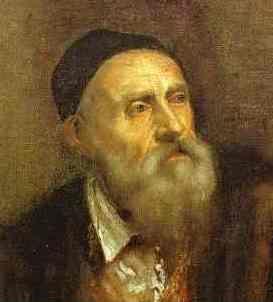
Titian or Tiziano Vecellio was born in a small alpine village of Pieve di Cadore, now not far from the Austrian border, where his family lived for many years. His parents, Lucia and Gregorio di Conte dei Vecelli, were respectable people of modest means. In about 1498, at the age of nine or ten, Titian and his elder brother Francesco were sent to Venice to start their training as painters in the workshop of the mosaicist Sebastiano Zuccato. Though soon Titian left his workshop and began studying painting in the workshops of Gentile Bellini and Giovanni Bellini. It is believed, that his earliest surviving work Pope Alexander VI Presenting Jacopo Pesaro to Saint Peter (1502-1512) was influenced by Giovanni Bellini. In 1507, Titian joined the workshop of Giorgione as his assistant and three years (until Giorgione's death in 1510), which he spent with this outstanding master, were a lasting influence on the young Titian to such a degree, that some works which are now thought to have been painted by Titian used to be attributed to Giorgione, and vice versa. One of them is Concert Champetre (c.1510-1511), which is still in some sources considered to be painted by Giorgione. Other works by Titian, which bear the Giorgione's influence are The Birth of Adonis (1505-1510), The Legend of Polydorus (1505-1510), St. Mark Enthroned with Saints (c.1510), The Concert (c.1510), Noli me tangere (1511-1512), Gypsy Madonna (c.1512) and even his masterpiece Sacred and Profane Love (1514).
In 1510 Titian received his first important commission to produce some frescoes in the Scuola del Santo in Padua dedicated the life of St. Anthony of Padua. Since that time Titian began to win independent commissions and to establish himself as a painter in Venice. In 1513 he opened his own workshop, in which he employed two assistants, one of whom had worked for Giovanni Bellini. In 1516 Titian was commissioned to paint a new work for the high altar in the Franciscan church of Santa Maria Gloriosa dei Frari in Venice, the Assumption of the Virgin (Assunta) (1516-1518), which was destined to become the milestone in the history of Venetian High Renaissance. This altarpiece made Titian the most celebrated painter in Venice. At the same time, it drew him to the attention of Bellini's old patrons in the northern Italian ruling houses. He was commissioned by the Duke of Ferrara Alfonso d'Este to produce three large mythological paintings The Worship of Venus (1518), Bacchus and Ariadne (1520-1522) and Bacchanal of the Andrians (1523-1525).
In the following years Titian painted another monumental altarpieces Pesaro Altarpiece (1519-1526) and Madonna in Glory with the Christ Child and Saints Francis and Alvise with the Donor Alvise Gozzi (1520), which set a standard for the future. His another masterpiece of the time the Martyrdom of St. Peter Martyr has been lost. In 1523 Titian first met Federico II Gonzaga, Duke of Mantua, who became one of his clients. On Duke's commissions he painted Portrait of Federico II Gonzaga (1523-1529) and also some religious paintings, such as Madonna and Child with St. Catherine and a Rabbit (1530). Federico II Gonzaga also introduced Titian to the Holy Roman Emperor Charles V.
The 1520s - 1540s were the years when Titian created his best portraits. The best, which survived, are A Knight of Malta (c.1510-1515), Young Man with Cap and Gloves (c.1512-1515), Man with a Glove (c.1520-1522), Portrait of Tomaso or Vincenzo Mosti (c.1526), Portrait of Ippolito de' Medici (1533), La Bella (1536), Portrait of Francesco Maria della Rovere, Duke of Urbino (c.1536-1538), The Young Englishman (c.1540-1545), Portrait of Cardinal Pietro Bembo (c.1540), Portrait of a Musician (c.1515 or c.1544-1546), Portrait of a Girl (Lavinia) (c.1545).
In 1533 Titian was called to the court of Charles V, where he was appointed a court painter and made a Count Palatine and Knight of the Golden Spur. Titian painted several portraits of Charles V, such as Portrait of Charles V (1533), Portrait of Emperor Charles V at Muhlberg (1548), Portrait of Emperor Charles V Seated (1548) and members of his family: Portrait of Isabella of Portugal (1548), Charles V's late wife, and his son Philip, the future Emperor, Portrait of Philip II in Armor (c.1550-1551), Portrait of Philip II (c.1554).
In 1538 Titian created another masterpiece Venus of Urbino (1538), one of the numerous paintings of a female nude depicting Titian's ideal of female beauty. Other famous Titian's women are Flora (c.1515-1520), Salome (c.1515), Venus Anadyomene (c.1520), Venus and Cupid with an Organist (c.1548), Danae with Nursemaid (1553-1554), Venus and Adonis (1553-1554), Pardo Venus (Jupiter and Antiope) (1535-1540) and even St. Mary Magdalene (c.1530-1535).
Titian created several commissions for the Pope Paul III from the Farnese family, among which Pope Paul III and His Grandsons Ottavio and Cardinal Alessandro Farnese (1545-1546), the picture was considered too revealing and was not finished.
By the end of the 1550s, Titian had come to value the exploration of the color above all other aspects of art. His style and technique were evolving from the more precise contours, modeling and finish of the early portraits to a much bolder, freer style with more highly charged brushwork; he handled the paint increasingly broadly, creating an effect almost like mosaic, with patches of color. It was noted of his late work (as it was later of the Impressionists) that while the painting did not cohere if seen close up, when seen from the "proper" distance it became brilliantly clear. For splendor of color, the climax was reached in some of Titian's late mythologies painted for Philip II: Diana and Callisto (1556-1559), Diana and Actaeon (1556-1559), The Rape of Europe (1562), Venus Blindfolding Cupid (c.1565). Among of his other late works the most notable are Allegory of Time Governed by Prudence (c.1565), Penitent St. Mary Magdalene (1565), Religion Succored by Spain (1572-1575), St. Sebastian (1575). Titian died on 27 August 1576, in his house in Biri Grande in Venice. He was buried in Santa Maria Gloriosa dei Frari for which he created several of his best works.
In very different ways, his art influenced painters such as Nicolas Poussin, Peter Paul Rubens, Anthony van Dyck, Diego Velazquez, Rembrandt, Francisco de Goya, Eugene Delacroix, Edouard Maner, Auguste Renoir, to name but a few.
Bibliography
Painting of Europe. XIII-XX centuries. Encyclopedic Dictionary. Moscow. Iskusstvo. 1999.
The Art of the Italian Renaissance. Architecture. Sculpture. Painting. Drawing. Könemann. 1995.
The Renaissance Artist at Work: From Pisano to Titian (Icon Editions Ser.) by Bruce Cole. Westview Press, 1984.
Titian to 1518: The Emergence of Genius by Paul Joannides. Yale Univ Pr, 2002.
Titian: Prince of Painters by Titian, Susanna Biadene (Editor), Mary Yakush, Palazzo Ducale. Prestel USA, 1990.
Titian's Women by Rona Goffen. Yale Univ Pr, 1997.
Titian (Masters of Italian Art Series) by Marion Kaminski. Konemann, 1998.
Titian by Filippo Pedrocco. Rizzoli International Publications, 2001.
Titian's Portraits Through Aretino's Lens by Luba Freedman, Pietro Aretino. Pennsylvania State University Press, 1995.
Titian: Essays by Charles Hope, Jennifer Fletcher, Jill Dunkerton. Yale University Press, 2003.
Bellini, Giorgione, Titian, and the Renaissance of Venetian Painting by David Alan Brown, Sylvia Ferino-Pagden. Yale University Press, 2006.
- Pope Alexander Vi Presenting Jacopo Pesaro To Saint Peter.
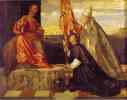
1502-1512. Oil on canvas. Koninklijk Museum voor Schone Kunsten, Antwerp, Belgium. Read Note.
- Concert Champetre.
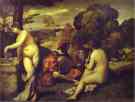
c.1510-1511. Oil on canvas. The Louvre, Paris, France.
- The Birth Of Adonis.

1505-1510. Oil? on wood. Museo Civico, Padua, Italy. Read Note.
- St. Mark Enthroned With Saints.

c.1510. Oil on canvas. Santa Maria della Salure, Venice, Italy. Read Note.
- The Concert.

c.1510. Oil on canvas. Palazzo Pitti, Galleria Palatina, Florence, Italy.
- Noli Me Tangere.
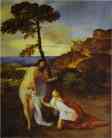
1511-1512. Oil on canvas. The National Gallery, London, UK. Read Note.
- Gypsy Madonna.
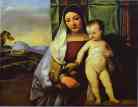
c.1512. Oil on wood. Kunsthistorisches Museum, Vienna, Austria.
- Sacred And Profane Love.

1514. Oil on canvas. Museo Galleria Borghese, Rome, Italy.
- The Miracle Of The Newborn Child.
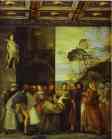
1511. Fresco. Scuola del Santo, Padua, Italy. Read Note.
- Assumption Of The Virgin (Assunta).

1516-1518. Oil on wood. Santa Maria Gloriosa dei Frari, Venice, Italy. Read Note.